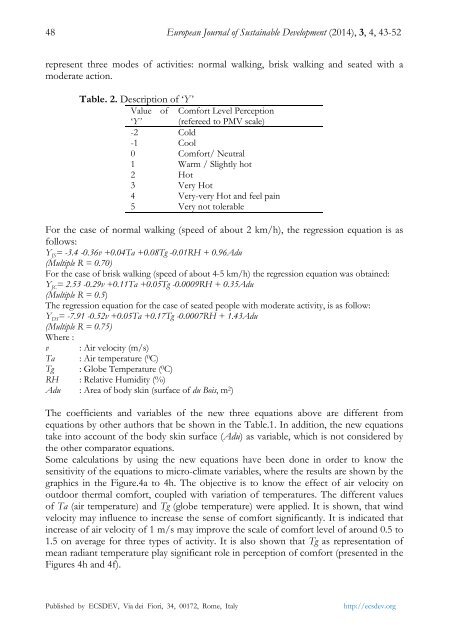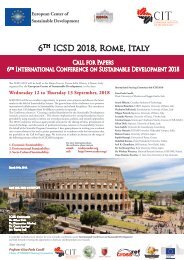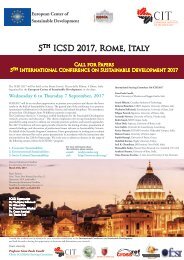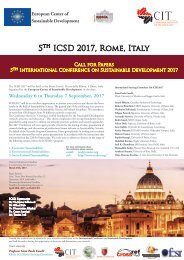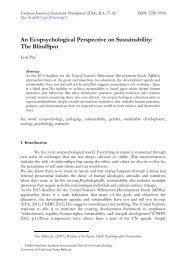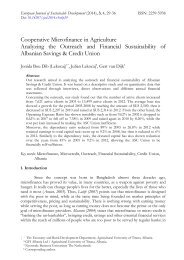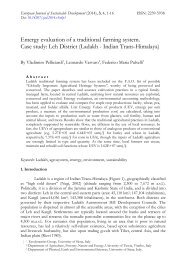European Journal of Sustainable Development (EJSD)
Rome Italy
Rome Italy
Create successful ePaper yourself
Turn your PDF publications into a flip-book with our unique Google optimized e-Paper software.
48 <strong>European</strong> <strong>Journal</strong> <strong>of</strong> <strong>Sustainable</strong> <strong>Development</strong> (2014), 3, 4, 43-52<br />
represent three modes <strong>of</strong> activities: normal walking, brisk walking and seated with a<br />
moderate action.<br />
Table. 2. Description <strong>of</strong> ‘Y’<br />
Value <strong>of</strong><br />
‘Y’<br />
Comfort Level Perception<br />
(refereed to PMV scale)<br />
-2 Cold<br />
-1 Cool<br />
0 Comfort/ Neutral<br />
1 Warm / Slightly hot<br />
2 Hot<br />
3 Very Hot<br />
4<br />
5<br />
Very-very Hot and feel pain<br />
Very not tolerable<br />
For the case <strong>of</strong> normal walking (speed <strong>of</strong> about 2 km/h), the regression equation is as<br />
follows:<br />
Y JS = -3.4 -0.36v +0.04Ta +0.08Tg -0.01RH + 0.96Adu<br />
(Multiple R = 0.70)<br />
For the case <strong>of</strong> brisk walking (speed <strong>of</strong> about 4-5 km/h) the regression equation was obtained:<br />
Y JC = 2.53 -0.29v +0.11Ta +0.05Tg -0.0009RH + 0.35Adu<br />
(Multiple R = 0.5)<br />
The regression equation for the case <strong>of</strong> seated people with moderate activity, is as follow:<br />
Y DS = -7.91 -0.52v +0.05Ta +0.17Tg -0.0007RH + 1.43Adu<br />
(Multiple R = 0.75)<br />
Where :<br />
v : Air velocity (m/s)<br />
Ta : Air temperature ( 0 C)<br />
Tg : Globe Temperature ( 0 C)<br />
RH : Relative Humidity (%)<br />
Adu : Area <strong>of</strong> body skin (surface <strong>of</strong> du Bois, m 2 )<br />
The coefficients and variables <strong>of</strong> the new three equations above are different from<br />
equations by other authors that be shown in the Table.1. In addition, the new equations<br />
take into account <strong>of</strong> the body skin surface (Adu) as variable, which is not considered by<br />
the other comparator equations.<br />
Some calculations by using the new equations have been done in order to know the<br />
sensitivity <strong>of</strong> the equations to micro-climate variables, where the results are shown by the<br />
graphics in the Figure.4a to 4h. The objective is to know the effect <strong>of</strong> air velocity on<br />
outdoor thermal comfort, coupled with variation <strong>of</strong> temperatures. The different values<br />
<strong>of</strong> Ta (air temperature) and Tg (globe temperature) were applied. It is shown, that wind<br />
velocity may influence to increase the sense <strong>of</strong> comfort significantly. It is indicated that<br />
increase <strong>of</strong> air velocity <strong>of</strong> 1 m/s may improve the scale <strong>of</strong> comfort level <strong>of</strong> around 0.5 to<br />
1.5 on average for three types <strong>of</strong> activity. It is also shown that Tg as representation <strong>of</strong><br />
mean radiant temperature play significant role in perception <strong>of</strong> comfort (presented in the<br />
Figures 4h and 4f).<br />
Published by ECSDEV, Via dei Fiori, 34, 00172, Rome, Italy<br />
http://ecsdev.org


